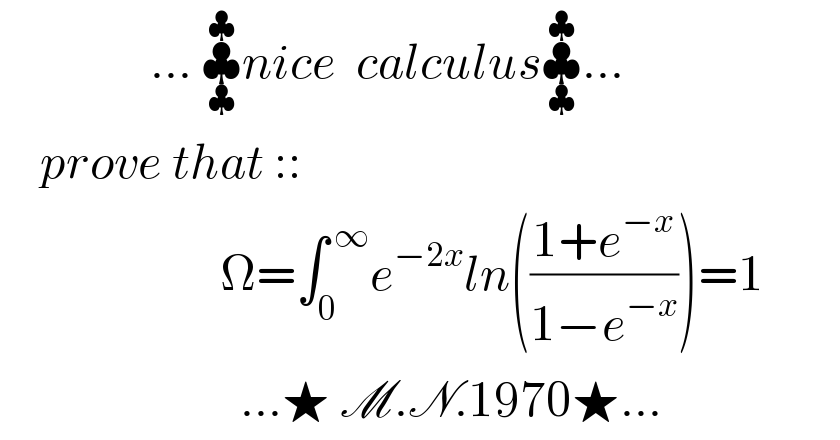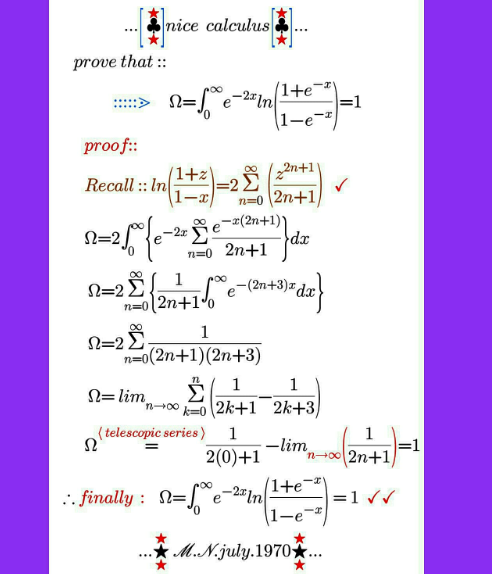
Question Number 119570 by mnjuly1970 last updated on 25/Oct/20

$$\:\:\:\:\:\:\:\:\:\:\:\:\:\:\:...\:\underset{\clubsuit} {\overset{\clubsuit} {\clubsuit}}{nice}\:\:{calculus}\underset{\clubsuit} {\overset{\clubsuit} {\clubsuit}}... \\ $$$$\:\:\:\:{prove}\:{that}\::: \\ $$$$\:\:\:\:\:\:\:\:\:\:\:\:\:\:\:\:\:\:\:\:\:\:\Omega=\int_{\mathrm{0}} ^{\:\infty} {e}^{−\mathrm{2}{x}} {ln}\left(\frac{\mathrm{1}+{e}^{−{x}} }{\mathrm{1}−{e}^{−{x}} }\right)=\mathrm{1} \\ $$$$\:\:\:\:\:\:\:\:\:\:\:\:\:\:\:\:\:\:\:\:\:\:\:\:...\bigstar\:\mathscr{M}.\mathscr{N}.\mathrm{1970}\bigstar... \\ $$
Answered by mindispower last updated on 25/Oct/20
![e^(−2x) =e^(−x) ∗e^(−x) let t=e^(−x) ⇒dt=−e^(−x) dx ⇔=∫_0 ^1 tln(((1+t)/(1−t)))dt=−∫_0 ^1 tln(((1−t)/(1+t)))dt x=((1−t)/(1+t))⇒t=((1−x)/(1+x)),dt=((−2)/((1+x)^2 ))dx ⇔−2∫_0 ^1 ((1−x)/((1+x)^3 ))ln(x)dx =−2[((1/((1+x)))−(1/((1+x)^2 )))ln(x)]_0 ^1 +2∫((1/((1+x)x))−(1/(x(1+x)^2 )))dx =2∫_0 ^1 (1/((1+x)^2 ))=2[−(1/((1+x)))]_0 ^1 =2.(1/2)=1](Q119589.png)
$${e}^{−\mathrm{2}{x}} ={e}^{−{x}} \ast{e}^{−{x}} \\ $$$${let}\:{t}={e}^{−{x}} \Rightarrow{dt}=−{e}^{−{x}} {dx} \\ $$$$\Leftrightarrow=\int_{\mathrm{0}} ^{\mathrm{1}} {tln}\left(\frac{\mathrm{1}+{t}}{\mathrm{1}−{t}}\right){dt}=−\int_{\mathrm{0}} ^{\mathrm{1}} {tln}\left(\frac{\mathrm{1}−{t}}{\mathrm{1}+{t}}\right){dt} \\ $$$${x}=\frac{\mathrm{1}−{t}}{\mathrm{1}+{t}}\Rightarrow{t}=\frac{\mathrm{1}−{x}}{\mathrm{1}+{x}},{dt}=\frac{−\mathrm{2}}{\left(\mathrm{1}+{x}\right)^{\mathrm{2}} }{dx} \\ $$$$\Leftrightarrow−\mathrm{2}\int_{\mathrm{0}} ^{\mathrm{1}} \frac{\mathrm{1}−{x}}{\left(\mathrm{1}+{x}\right)^{\mathrm{3}} }{ln}\left({x}\right){dx} \\ $$$$=−\mathrm{2}\left[\left(\frac{\mathrm{1}}{\left(\mathrm{1}+{x}\right)}−\frac{\mathrm{1}}{\left(\mathrm{1}+{x}\right)^{\mathrm{2}} }\right){ln}\left({x}\right)\right]_{\mathrm{0}} ^{\mathrm{1}} +\mathrm{2}\int\left(\frac{\mathrm{1}}{\left(\mathrm{1}+{x}\right){x}}−\frac{\mathrm{1}}{{x}\left(\mathrm{1}+{x}\right)^{\mathrm{2}} }\right){dx} \\ $$$$=\mathrm{2}\int_{\mathrm{0}} ^{\mathrm{1}} \frac{\mathrm{1}}{\left(\mathrm{1}+{x}\right)^{\mathrm{2}} }=\mathrm{2}\left[−\frac{\mathrm{1}}{\left(\mathrm{1}+{x}\right)}\right]_{\mathrm{0}} ^{\mathrm{1}} =\mathrm{2}.\frac{\mathrm{1}}{\mathrm{2}}=\mathrm{1} \\ $$$$ \\ $$
Commented by mnjuly1970 last updated on 25/Oct/20

$${thank}\:{you}\:{mr}\:{power}.. \\ $$
Answered by mathmax by abdo last updated on 25/Oct/20
![I =∫_0 ^∞ e^(−2x) ln(((1+e^(−x) )/(1−e^(−x) )))dx ⇒I =∫_0 ^∞ e^(−2x) ln(1+e^(−x) )dx−∫_0 ^∞ e^(−2x) ln(1−e^(−x) )dx =H−K H =∫_0 ^∞ e^(−2x) ln(1+e^(−x) )dx =_(e^(−x) =t) −∫_0 ^1 t^2 ln(1+t)(((−dt)/t))dt =∫_0 ^1 tln(1+t)dt =[(t^2 /2)ln(1+t)]_0 ^1 −∫_0 ^1 (t^2 /(2(1+t)))dt =((ln2)/2)−(1/2)∫_0 ^1 ((t^2 −1+1)/(t+1))dt =((ln2)/2)−(1/2){∫_0 ^1 (t−1)dt+∫_0 ^1 (dt/(t+1))} =((ln2)/2)−(1/2){[(t^2 /2)−t]_0 ^1 +ln(2)} =−(1/2)(−(1/2))=(1/4) K=∫_0 ^∞ e^(−2x) ln(1−e^(−x) )dx =_(e^(−x) =t) −∫_0 ^1 t^2 ln(1−t)(((−dt)/t)) =∫_0 ^1 tln(1−t)dt =[(1/2)(t^2 −1)ln(1−t)]_0 ^1 −∫_0 ^1 ((t^2 −1)/2)×((−1)/(1−t))dt =−(1/2)∫_0 ^1 (t+1)dt =−(1/2)[(t^2 /2)+t]_0 ^1 =−(1/2)((3/2))=−(3/4) ⇒ I =H−K =(1/4)+(3/4) ⇒ ★ I =1★](Q119607.png)
$$\mathrm{I}\:=\int_{\mathrm{0}} ^{\infty} \:\mathrm{e}^{−\mathrm{2x}} \mathrm{ln}\left(\frac{\mathrm{1}+\mathrm{e}^{−\mathrm{x}} }{\mathrm{1}−\mathrm{e}^{−\mathrm{x}} }\right)\mathrm{dx}\:\Rightarrow\mathrm{I}\:=\int_{\mathrm{0}} ^{\infty} \mathrm{e}^{−\mathrm{2x}} \mathrm{ln}\left(\mathrm{1}+\mathrm{e}^{−\mathrm{x}} \right)\mathrm{dx}−\int_{\mathrm{0}} ^{\infty} \mathrm{e}^{−\mathrm{2x}} \mathrm{ln}\left(\mathrm{1}−\mathrm{e}^{−\mathrm{x}} \right)\mathrm{dx} \\ $$$$=\mathrm{H}−\mathrm{K} \\ $$$$\mathrm{H}\:=\int_{\mathrm{0}} ^{\infty} \:\mathrm{e}^{−\mathrm{2x}} \mathrm{ln}\left(\mathrm{1}+\mathrm{e}^{−\mathrm{x}} \right)\mathrm{dx}\:=_{\mathrm{e}^{−\mathrm{x}} =\mathrm{t}} \:\:−\int_{\mathrm{0}} ^{\mathrm{1}} \mathrm{t}^{\mathrm{2}} \mathrm{ln}\left(\mathrm{1}+\mathrm{t}\right)\left(\frac{−\mathrm{dt}}{\mathrm{t}}\right)\mathrm{dt} \\ $$$$=\int_{\mathrm{0}} ^{\mathrm{1}} \mathrm{tln}\left(\mathrm{1}+\mathrm{t}\right)\mathrm{dt}\:\:=\left[\frac{\mathrm{t}^{\mathrm{2}} }{\mathrm{2}}\mathrm{ln}\left(\mathrm{1}+\mathrm{t}\right)\right]_{\mathrm{0}} ^{\mathrm{1}} −\int_{\mathrm{0}} ^{\mathrm{1}} \:\frac{\mathrm{t}^{\mathrm{2}} }{\mathrm{2}\left(\mathrm{1}+\mathrm{t}\right)}\mathrm{dt} \\ $$$$=\frac{\mathrm{ln2}}{\mathrm{2}}−\frac{\mathrm{1}}{\mathrm{2}}\int_{\mathrm{0}} ^{\mathrm{1}} \frac{\mathrm{t}^{\mathrm{2}} −\mathrm{1}+\mathrm{1}}{\mathrm{t}+\mathrm{1}}\mathrm{dt}\:=\frac{\mathrm{ln2}}{\mathrm{2}}−\frac{\mathrm{1}}{\mathrm{2}}\left\{\int_{\mathrm{0}} ^{\mathrm{1}} \left(\mathrm{t}−\mathrm{1}\right)\mathrm{dt}+\int_{\mathrm{0}} ^{\mathrm{1}} \:\frac{\mathrm{dt}}{\mathrm{t}+\mathrm{1}}\right\} \\ $$$$=\frac{\mathrm{ln2}}{\mathrm{2}}−\frac{\mathrm{1}}{\mathrm{2}}\left\{\left[\frac{\mathrm{t}^{\mathrm{2}} }{\mathrm{2}}−\mathrm{t}\right]_{\mathrm{0}} ^{\mathrm{1}} \:+\mathrm{ln}\left(\mathrm{2}\right)\right\}\:=−\frac{\mathrm{1}}{\mathrm{2}}\left(−\frac{\mathrm{1}}{\mathrm{2}}\right)=\frac{\mathrm{1}}{\mathrm{4}} \\ $$$$\mathrm{K}=\int_{\mathrm{0}} ^{\infty} \:\mathrm{e}^{−\mathrm{2x}} \mathrm{ln}\left(\mathrm{1}−\mathrm{e}^{−\mathrm{x}} \right)\mathrm{dx}\:=_{\mathrm{e}^{−\mathrm{x}} =\mathrm{t}} \:\:−\int_{\mathrm{0}} ^{\mathrm{1}} \:\mathrm{t}^{\mathrm{2}} \mathrm{ln}\left(\mathrm{1}−\mathrm{t}\right)\left(\frac{−\mathrm{dt}}{\mathrm{t}}\right) \\ $$$$=\int_{\mathrm{0}} ^{\mathrm{1}} \:\mathrm{tln}\left(\mathrm{1}−\mathrm{t}\right)\mathrm{dt}\:=\left[\frac{\mathrm{1}}{\mathrm{2}}\left(\mathrm{t}^{\mathrm{2}} −\mathrm{1}\right)\mathrm{ln}\left(\mathrm{1}−\mathrm{t}\right)\right]_{\mathrm{0}} ^{\mathrm{1}} −\int_{\mathrm{0}} ^{\mathrm{1}} \frac{\mathrm{t}^{\mathrm{2}} −\mathrm{1}}{\mathrm{2}}×\frac{−\mathrm{1}}{\mathrm{1}−\mathrm{t}}\mathrm{dt} \\ $$$$=−\frac{\mathrm{1}}{\mathrm{2}}\int_{\mathrm{0}} ^{\mathrm{1}} \:\left(\mathrm{t}+\mathrm{1}\right)\mathrm{dt}\:=−\frac{\mathrm{1}}{\mathrm{2}}\left[\frac{\mathrm{t}^{\mathrm{2}} }{\mathrm{2}}+\mathrm{t}\right]_{\mathrm{0}} ^{\mathrm{1}} \:=−\frac{\mathrm{1}}{\mathrm{2}}\left(\frac{\mathrm{3}}{\mathrm{2}}\right)=−\frac{\mathrm{3}}{\mathrm{4}}\:\Rightarrow \\ $$$$\mathrm{I}\:=\mathrm{H}−\mathrm{K}\:=\frac{\mathrm{1}}{\mathrm{4}}+\frac{\mathrm{3}}{\mathrm{4}}\:\Rightarrow\:\bigstar\:\mathrm{I}\:=\mathrm{1}\bigstar \\ $$$$ \\ $$
Commented by mnjuly1970 last updated on 25/Oct/20

$${thank}\:{you}\:{mr}\:{max}.. \\ $$
Commented by Bird last updated on 25/Oct/20

$${you}\:{are}\:{welcome} \\ $$
Answered by mnjuly1970 last updated on 25/Oct/20

Commented by mnjuly1970 last updated on 25/Oct/20

$${edittion}\:: \\ $$$$\mathrm{1}:\:\:{recall}\:::\:{ln}\left(\frac{\mathrm{1}+{z}}{\mathrm{1}−{z}}\right)=\mathrm{2}\underset{{n}=\mathrm{0}} {\overset{\infty} {\sum}}\frac{{z}^{\mathrm{2}{n}+\mathrm{1}} }{\mathrm{2}{n}+\mathrm{1}} \\ $$$$\mathrm{2}\::\:\Omega\overset{{telescopic}\:{series}} {=}\frac{\mathrm{1}}{\mathrm{2}\left(\mathrm{0}\right)+\mathrm{1}}−{lim}_{{n}\rightarrow\infty} \left(\frac{\mathrm{1}}{\mathrm{2}{n}+\mathrm{3}}\right)=\mathrm{1} \\ $$$$\:\:\:\:\:\:\:\:\:\:\:\:\:...{m}.{n}.{july}.\mathrm{1970}... \\ $$
